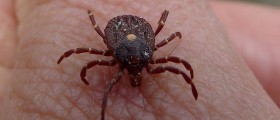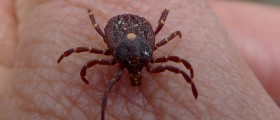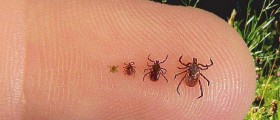Lyme disease belongs to infectious diseases. It is caused by the bacterium Borrelia burgdorferi and transmitted by tick bites. It is of great importance to recognize symptoms and signs of Lyme disease while it is in its initial stage. Only then the bacterium can be eradicated and serious complications to vital organs prevented. Left untreated the disease progresses, goes through several stages and may cause serious complications even many years after the person has been infected.
Who’s at Risk?
The risk for Lyme disease is rather high among individuals who are engaged in activities that increase tick exposure like gardening, hiking, hunting etc. Furthermore, owners of pets that may carry ticks home are another group of people at higher risk for the disease. Finally, it is easy to get exposed to ticks if one is walking in high grass especially if his/her legs are not covered.

Ticks
Deer ticks can be quite small and one may never notice the actual culprit responsible for transmission of the disease. It is no wander that such individuals, especially if the symptoms of the initial stage of the disease are mild, may easily end up with chronic form of the disease and develop serious long-term complications.
Lyme Disease Stages
Lyme disease may go through three stages. The first stage is also referred to primary Lyme disease. The second stage (secondary Lyme disease) represents early disseminated Lyme disease while stage 3 of the disease (tertiary Lyme disease) is actually chronic and persistent form of the disease.
- Erythema migrans is diagnostic of Lyme disease. Use a combination of clinical presentation and laboratory testing to guide diagnosis and treatment in people without erythema migrans.
- Lyme disease can occur anywhere.
- Serological testing is a two tier approach: a sensitive initial test is performed first (ELISA), followed by a more specific confirmatory test (immunoblot) in case of a positive or equivocal initial result.
- Symptoms of Lyme disease may take months or years to resolve even after treatment for several reasons, including alternative diagnoses, reinfection, treatment failure, immune reaction, and organ damage caused by Lyme disease.
- Consider a second course of antibiotics for people with ongoing symptoms as treatment may have failed.
Lyme Disease Symptoms
The initial symptoms of Lyme disease resemble flu and include fever accompanied by chills, headache, lethargy and muscle pain. At the bite site the skin is covered with a typical rash called bull’s eye rash (erythema migrans). It comprises a flat or slightly raised red spot with a clear area in the center. The rash may be rather big and even exceed 3 inches in diameter.
The skin redness may linger for a month. Weeks to months after the exposure to the bacterium, it multiplies and spreads all over the body. The disease affects different organs and organ systems causing many times serious damage and leading to disability of different intensity. In advanced stage of Lyme disease the most commonly affected organs and organ systems are joints, heart and nervous system.
Last Stage of Lyme Disease
Symptoms of the last stage may differ depending on the affected organs. Inflammation of the heart muscle is, for instance, the cause of abnormal heart rhythms and heart failure. If the nervous system is affected, one may end up with Bell's paralysis, peripheral neuropathy, meningitis and different mental changes. Arthritis is another potential complication usually accompanied by swelling, stiffness and pain.
















Your thoughts on this
Loading...